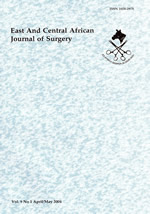
|
East and Central African Journal of Surgery
Association of Surgeons of East Africa and College of Surgeons of East Central and Southern Africa
ISSN: 1024-297X
EISSN: 1024-297X
Vol. 11, No. 2, 2006, pp. 72-77
|
 Bioline Code: js06038
Bioline Code: js06038
Full paper language: English
Document type: Research Article
Document available free of charge
|
|
|
East and Central African Journal of Surgery, Vol. 11, No. 2, 2006, pp. 72-77
| en |
Challenges in the Management of Benign Oesophageal Strictures in Zambians
L. Munkonge
Abstract
Background: Benign Oesophageal structures are common in Zambians and pose great challenge in their management. Infants and, children are more affected than adults. Conservative and surgical treatments have been deployed in this institute and each of these methods have their advantages and disadvantages.
Methods: Operative technique consisted of 32 adult patients (15.6%) using isoperistaltic transverse colonic segment the length of which can be extended from ascending to descending colon depending on the distance between lower thyroid cartilage and the stomach. The transverse colon was passed subcutaneously. The first stage was feeding colostomy, which was followed by definitive operation.
Results: Two hundred and five Zambians with benign oesophageal stricture caused by ingestion of corrosive substances were seen in a period of 20 years from 1985 to 2005 inclusive. The majority (84.4%) were Zambian infants aged below 3 years. The remaining 32 patients (15.6%) were adults aged from the ages of 15 to 64 years giving a mean age of 41 years. Corrosives were taken accidentally in 84.9% while in the remaining 31 (15.1%) drank corrosives in suicidal attempt. All the babies were treated conservatively using bouginage and gastrostomy. Five infants who came in irreversible shock died. The 32 (15.6%) had gastrostomy for feeding the patients with failed attempted bouginage and got anterior sternal transverse colon oesophageal replacement. Morbidity was high but mortality was nil. We found this operation suitable for third world countries since there was no need for parental feeds. The operation restored ability to take food orally in 80% as compared to 26% of patients with bouginage.
Conclusion: Confident vascularity depending on middle colic and left colic is guaranteed by low incidence of stenosis. The functional results are excellent as compared to minor complications which can be corrected early.
|
| |
© Copyright 2006 - East and Central African Journal of Surgery
|
|
